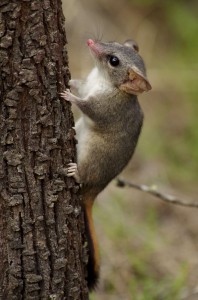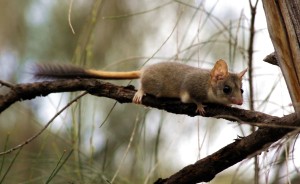Podcast: Play in new window | Download (Duration: 6:41 — 7.8MB)
Thanks to Kristie for suggesting this week’s topic, the phascogale!
Further reading:
Red-tailed phascogales (all photos below come from this site)
Sleeping phascogale:

Wide-awake phascogales:


Show transcript:
Welcome to Strange Animals Podcast. I’m your host, Kate Shaw.
Ages ago, Kristie suggested I look up the phascogale, a really cute Australian animal. It’s definitely adorable and a little bit weird, so let’s learn about it this week!
Like most mammals that live in Australia, the phascogale is a marsupial. That means that the babies are born very early, then finish developing in their mother’s pouch. In this case, though, the phascogale mother doesn’t have a real pouch. Instead, when the mother is pregnant she develops what’s called a pseudo-pouch. Pseudo means false, so it’s not really a pouch although it resembles one. The pseudo-pouch is made up of folds of skin that develop around the mother’s teats, which protects the babies and keeps them warm. Since every baby needs its own teat at this stage, and the mother only has eight teats, if more than eight babies are born, the extra ones die.
The babies stay in the pseudo-pouch for about a month and a half, at which point they’re big enough that the mother can’t carry them around anymore. She makes a nest for them in a hollow tree, where they stay for another several months. She leaves them in the nest while she finds food, but comes back periodically to take care of them.
The phascogale is silvery-gray or gray-brown with a long tail that’s fluffy and black toward the end. It looks sort of like a mouse or rat with a long nose and a squirrel-like tail that’s almost as long as its body. It’s almost as big as a squirrel, up to about 10 inches long not including its tail, or 26 cm. Despite its resemblance to a rodent, the phascogale isn’t related to rodents at all. Rodents are placental mammals, not marsupial mammals.
The phascogale is nocturnal and mostly eats insects and spiders, but it will eat birds and mice too. It especially likes to eat cockroaches, yum. It mostly lives in trees although it will also hunt on the ground or in low brush, and it can jump long distances.
During the day the phascogale sleeps in a little hollow in a tree. It actually enters torpor while it’s asleep in order to save energy, which means it lowers its metabolic rate and its body temperature. But it can rev itself up again in only a few minutes when it needs to.
The strangest thing about the phascogale is that after mating season the males die. Mating season takes place over about three weeks in mid-winter, during which time a female may mate with several males. She’s able to store sperm in her body until she’s ready to have babies several months later, at which point she uses the stored sperm to fertilize her eggs. As a result, babies born in a single litter may have different fathers.
The males expend so much energy during these three weeks of mating season that they die of stress-related illnesses. In captivity, where the males can be treated by a veterinarian, a male who survives his first mating season can live as long as three years, but he doesn’t mate again. The female usually only has one litter of babies in her life even if she lives for several years.
The phascogale is closely related to the antechinus, which looks similar but has a skinny tail instead of a fluffy one. Antechinus males also die after mating season, while females give birth to tiny babies who latch onto a teat in the pseudo-pouch and stay there while they continue to develop, just like phascogales. Unlike phascogales, though, which always have eight teats, female antechinuses have different numbers of teats. How many teats a female has depends on where she lives. (Just a reminder, the word teats is another word for nipples.) Populations that live in areas where there’s plenty of food have more nipples, up to 13 but usually 12 at most. Populations that live in areas where it’s hard to find enough food have as few as 6 nipples. Producing milk for 12 or 13 babies requires a lot of energy, so females with more nipples can only survive and successfully raise that many babies when they have plenty of food. Females with only 6 nipples can survive on less food while still producing enough milk for six babies.
It seems strange that phascogale and antechinus males die after mating, but from an evolutionary standpoint, it makes sense. Both these animals are small and very likely to end up eaten by a larger animal. Odds are good that any given male won’t live long enough to see a second mating season anyway, so instead of conserving energy to stay alive, he expends all his energy during his first mating season to make sure he passes his genes along to the next generation.
One last interesting fact about the phascogale is that the red-tailed phascogale doesn’t need to drink water. It gets all the moisture it needs from its diet, which remember consists of insects and other animals. I guess animals are pretty moist on the inside. Don’t think about that too hard.
You can find Strange Animals Podcast at strangeanimalspodcast.blubrry.net. That’s blueberry without any E’s. If you have questions, comments, or suggestions for future episodes, email us at strangeanimalspodcast@gmail.com. If you like the podcast and want to help us out, leave us a rating and review on Apple Podcasts or Podchaser, or just tell a friend. We also have a Patreon at patreon.com/strangeanimalspodcast if you’d like to support us for as little as one dollar a month and get monthly bonus episodes.
Thanks for listening!